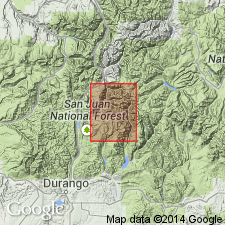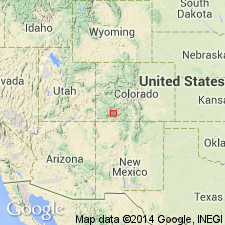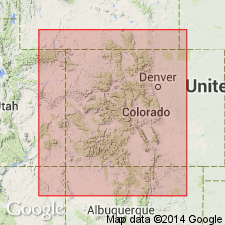
- Usage in publication:
-
- Whitehead granite*
- Modifications:
-
- Original reference
- Dominant lithology:
-
- Granite
- AAPG geologic province:
-
- Southern Rocky Mountain region
Summary:
Whitehead granite. Reddish pink biotite granite. Intrudes Archean schists but does not intrude the Algonkian rocks, and is therefore assumed to be older than Algonkian.
Named from occurrence about mouth of Whitehead Gulch, [San Juan Co.], this quadrangle.
Source: US geologic names lexicon (USGS Bull. 896, p. 2321).

- Usage in publication:
-
- Whitehead Granite*†
- Modifications:
-
- Abandoned
Summary:
Named for exposures in Needle Mountains in several small stocks and dikes in and around Whitehead Gulch, tributary of Animas River about 4 mi south of Silverton. Two rock types were found in this study. One is the earlier concordant lenticular bodies of strongly foliated or lineated, fine- to medium-grained quartz monzonite, granodiorite, and light-colored quartz diorite. The oligoclase-albite is altered to sericite and brown clay, and chlorite and epidote occur as well as biotite. A second or later type is massive, medium- to coarse-grained biotite quartz monzonite. The original description of Whitehead was of a pink or red granite containing little oligoclase, a description that matches the stocks but not all of the dikes. The earlier type of dike was deformed and metamorphosed with the Irving Formation and later retrograde metamorphism in the Uncompahgran. The second type was intruded after metamorphism of the Irving and later modified by the Uncompahgran disturbance. The earlier type is 1,780 +/-20 m.y. (U-Pb). The second is 1,720 +/-20 m.y. (U-Pb) and 1,695 +/-65 (Rb-Sr). Is similar to and mapped as Tenmile Granite 7 mi south of Silverton. Geologic map. Name Whitehead abandoned.
Source: GNU records (USGS DDS-6; Denver GNULEX).

- Usage in publication:
-
- Whitehead Granite
- Modifications:
-
- Overview
- AAPG geologic province:
-
- Southern Rocky Mountain region
Summary:
Abandoned by Barker (1969). Was a granitic rock of circa 1,700 m.y. (Precambrian X) age group in Needle Mountains.
Source: GNU records (USGS DDS-6; Denver GNULEX).
For more information, please contact Nancy Stamm, Geologic Names Committee Secretary.
Asterisk (*) indicates published by U.S. Geological Survey authors.
"No current usage" (†) implies that a name has been abandoned or has fallen into disuse. Former usage and, if known, replacement name given in parentheses ( ).
Slash (/) indicates name conflicts with nomenclatural guidelines (CSN, 1933; ACSN, 1961, 1970; NACSN, 1983, 2005, 2021). May be explained within brackets ([ ]).

